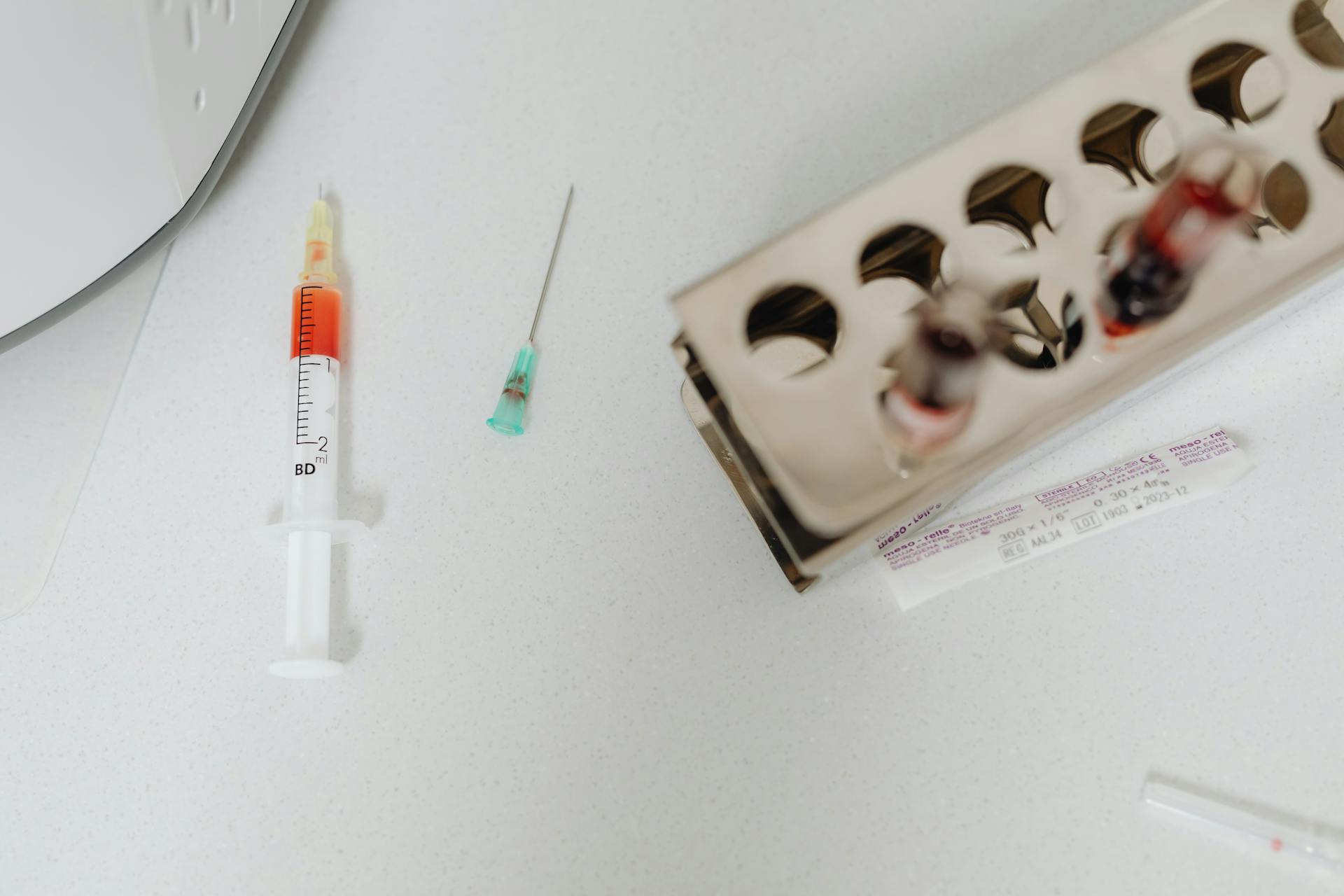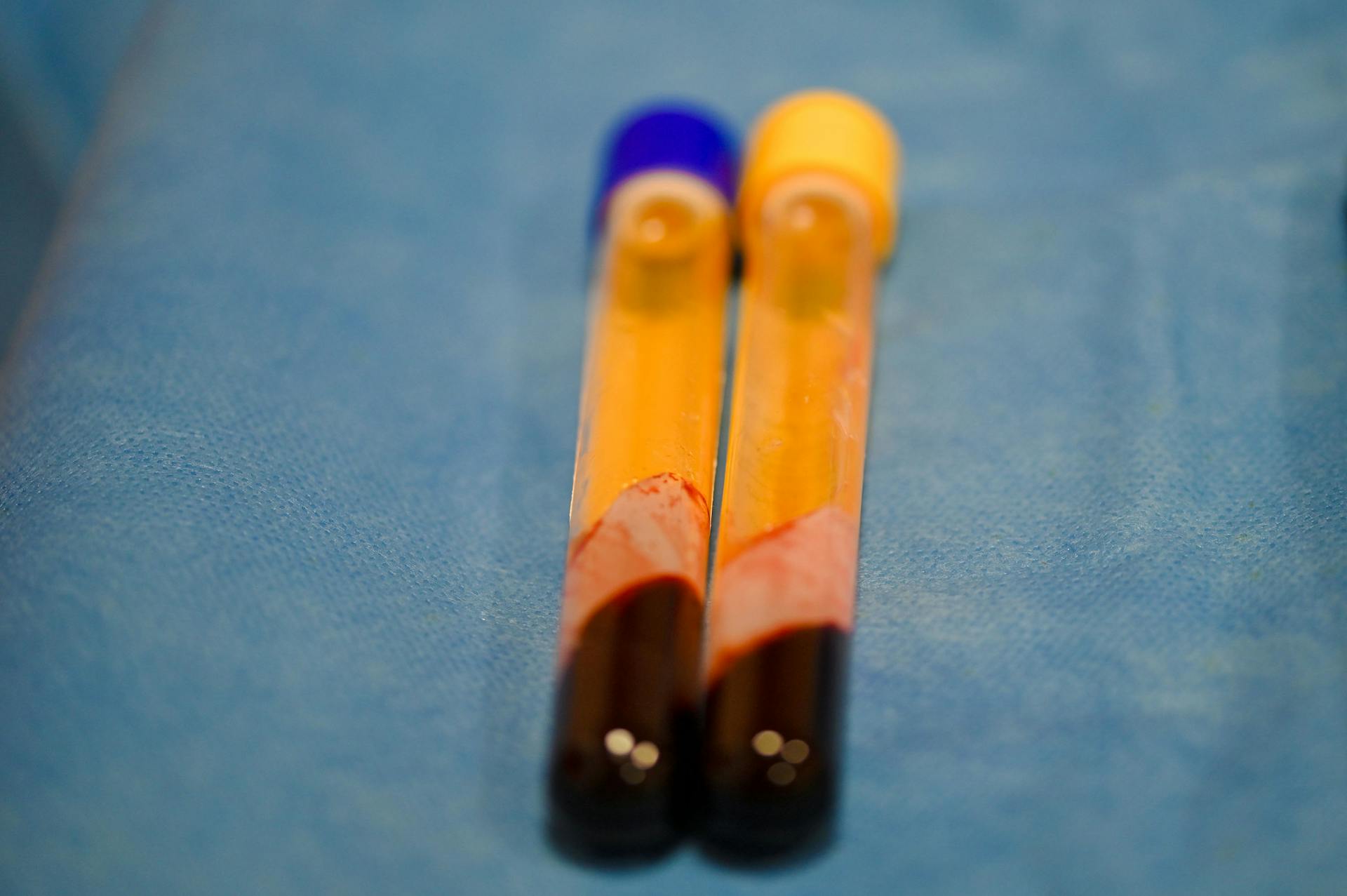
Canine brucellosis is a serious bacterial infection that can have severe consequences for dogs and even humans. The infection is caused by the Brucella canis bacterium.
Testing for canine brucellosis typically involves a combination of physical examination, medical history, and laboratory tests. A veterinarian will perform a physical examination to look for signs of illness such as fever, swollen lymph nodes, or reproductive problems.
Blood tests are a crucial part of the diagnostic process for canine brucellosis. These tests can detect the presence of antibodies in a dog's blood that are produced in response to the Brucella canis bacterium.
Expand your knowledge: Dog Upper Respiratory Infection vs Kennel Cough
What Is Brucellosis?
Brucellosis is a contagious infection caused by the bacterium Brucella canis.
This bacterial infection is highly contagious between dogs.
Infected dogs usually develop an infection of the reproductive system, or a venereal infection.
On a similar theme: Is Pyometra Contagious
Causes and Diagnosis
Canine brucellosis is usually diagnosed by a blood test. The Ohio ADDL uses an indirect fluorescent antibody (IFA) test that tests sera at 1/50 dilution.
This test is used for screening of breeding dogs, and negative tests are reliable unless the dog has been recently exposed to the disease.
Up to five samples can be pooled for IFA testing, which costs $16.50 per pool.
Prevention and Control
Prevention and control of canine brucellosis is crucial to prevent the spread of the disease. Most dogs are at risk of contracting the disease, especially those in kennel situations.
The disease is more prevalent in some areas, such as the southern USA, and in other parts of the world. This is why regular testing is necessary to prevent outbreaks.
All dogs used for breeding purposes should be tested regularly, ideally every 3-6 months, depending on their exposure to other dogs. This regular testing will help identify any potential cases early on.
New dogs should never be introduced into a kennel situation until they have been quarantined for 8-12 weeks and then tested for the disease. This quarantine period is crucial to prevent the spread of the disease.
Most experts recommend performing 2 blood tests 60 days apart, near the end of the quarantine period. This ensures accurate results and helps prevent false positives.
In most states, including Ohio, brucellosis is a reportable disease, meaning veterinarians are required to report all positive cases to the State Veterinarian. This is a critical step in controlling the spread of the disease.
A different take: How to Prevent Diabetes in Dogs
Testing and Results
The Ohio Administrative Code mandates that acceptable tests for detecting canine brucellosis include culture, IFA, and/or TAT.
At the ADDL, canine brucellosis testing is conducted daily using three available tests: Culture, Indirect Fluorescence Antibody (IFA) test, and Tube Agglutination Test (TAT).
Use an ice pack as a coolant for all Canine Brucellosis test specimens to ensure accurate results.
A negative test result for both antigens provides a strong indication that antibodies against Brucella were not present in the sample.
All samples containing antibodies against PO1 and/or BP26 antigens are tested for confirmation by Canine Brucella Slide Agglutination/AGID II tests at the AHDC.
For another approach, see: Canine Brucellosis Symptoms
Diagnostic Options
Diagnostic options for canine brucellosis testing are available at the Animal Disease Diagnostic Laboratory (ADDL). Three tests are conducted daily: Culture, Indirect Fluorescence Antibody (IFA) test, and Tube Agglutination Test (TAT).
To prepare your samples, it's essential to use an ice pack as a coolant for all Canine Brucellosis test specimens. This is a crucial step to ensure accurate results.
The Ohio Administrative Code mandates that acceptable tests for detection of B. canis include culture, IFA, and/or TAT.
Diagnostic Options

The Canine Brucella Multiplex Assay is just one of the diagnostic options available for detecting Brucella-specific antibodies in canine serum. Developed at the Animal Health Diagnostic Center at Cornell University, it detects antibodies to two different B. canis antigens in a single sample.
This assay is based on antigen-coated fluorescent beads and provides enhanced sensitivity for the detection of Brucella-specific antibodies. Seroconversion following infection with B. canis typically requires at least 3-4 weeks, but may take as long as 8-12 weeks.
The assay has several advantages, including high sensitivity, estimated to exceed 95%. It also offers a rapid turn-around time, with negative test results typically available within 1 business day.
If you're looking for other diagnostic options, the Animal Health Diagnostic Center at ADDL offers three tests: Culture, Indirect Fluorescence Antibody (IFA) test, and Tube Agglutination Test (TAT). These tests are mandated by the Ohio Administrative Code and are used for the detection of B. canis.
Broaden your view: Canine Cancer Detection

Here are the three available tests:
It's worth noting that all Canine Brucellosis test specimens require an ice pack as a coolant for transport and storage.
Sample Submission Requirements
To perform diagnostic testing for Brucella canis in Ohio, you'll need to submit a sample with an official animal identification.
As of August 22, 2015, Brucella canis is a reportable disease in Ohio, making B. canis diagnostic testing a regulatory test. This means additional requirements apply for submission of specimens and result reporting to the State Animal Health Official.
An accredited veterinarian must identify any canine to be tested for B. canis with an approved identification method. One such method is a microchip.
For USDA licensed kennels, a neck chain with an individual official USDA identification tag is also acceptable. However, this method is only allowed for kennels with a USDA license.
Licensing aside, there's another approved identification method for licensed High Volume Dog Breeder operations. This is a tag with the "Ohio HVDB license # (CB…)" and individual dog number.
Sample Submission
To perform diagnostic testing for canine brucellosis in Ohio, you'll need to submit a sample with an official animal identification.
An accredited veterinarian must identify the dog with one of the approved methods, which include a microchip or a neck chain with an individual official USDA identification tag.
Only USDA licensed kennels can use the USDA identification tag for identification.
Licensed High Volume Dog Breeder (HVDB) operations have an additional approved method, which is a tag with the "Ohio HVDB license # (CB...) and individual dog number".
The submission form must accompany the sample, and it's essential to include the official animal identification on the form.
You must submit the sample to the ADDL, and it's crucial to follow the additional requirements for regulatory tests, as canine brucellosis is a reportable disease in Ohio.
Frequently Asked Questions
How much does the Brucella canis test cost?
The Brucella canis test costs approximately £77.00. Results may take around a week to receive.
How do I know if my dog has Brucella?
Look for symptoms like infertility, weight loss, and swollen lymph nodes in your dog, and seek veterinary attention if you notice any unusual signs. If left untreated, canine brucellosis can lead to serious health issues, so it's essential to get your dog checked by a vet if you suspect Brucella
How often should a stud dog be tested for brucellosis?
Test your stud dog for brucellosis every 6 months, or before each breeding, to ensure the health and well-being of your breeding program
Sources
- https://www.vet.cornell.edu/about-us/news/new-test-developed-cvm-detect-brucella-canis
- https://agri.ohio.gov/programs/animal-disease-diagnostic-lab/resources/canine-brucellosis
- https://www.vet.cornell.edu/animal-health-diagnostic-center/testing/testing-protocols-interpretations/brucella-multiplex-testing-dogs
- https://www.ksvdl.org/resources/news/diagnostic_insights/november2020/diagnostic-options-canine-brucellosis.html
- https://www.dvm360.com/view/canine-brucellosis-proceedings
Featured Images: pexels.com


